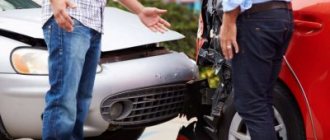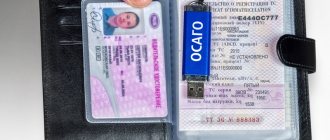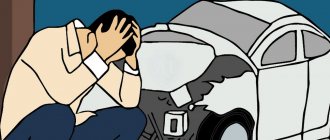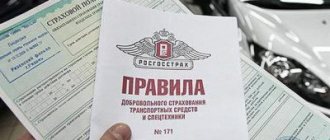CASCO: general concept
CASCO is voluntary vehicle insurance. These capital letters are not an abbreviation, so the name cannot be deciphered.
By purchasing a policy, a car owner can insure his property against:
- traffic accident;
- theft (theft);
- falling objects and many other troubles that can cause damage to the car.
It is noteworthy that if you have a CASCO insurance policy, a car owner involved in an accident can count on receiving payment even if it was his actions that led to the collision. In order to obtain compensation for damage, the driver must strictly adhere to the terms of treatment and the procedure for action after an accident established by the traffic rules, the Insurance Rules and the terms of the contract.
Accident involving two cars
The sequence of actions in such an accident is practically no different from that discussed above with one participant:
- Start with the emergency gang, if it is not damaged.
- Install an emergency warning sign so that other drivers can change lanes in advance and avoid creating traffic jams.
- Do not get into altercations with other participants in the accident. This will negatively affect the further development of events.
- Call an ambulance if there are victims.
- Call the traffic police.
- Do not move your car from the location until the traffic police inspector arrives.
- Take a photo of the incident. Take photographs of your car and the vehicles of others involved in the accident.
- When the traffic police arrives, try to take part in the inspection of your car. Do not leave the inspector alone with other participants in the accident. Police officers may not issue any certificates on site. So don't demand it.
- Record the details of the remaining participants in the incident: full name, residential address, place of work, etc. The more information is collected, the more likely it is to help.
- After inspection and drawing up a report, you can drive your car away.
Actions after an accident:
- You must pick up the report at the traffic police department. Find out the address from the inspector who arrived at the scene of the accident.
- Go to the CASCO insurance company for damages with the above documents.
CASCO and OSAGO: how do insurances differ?
Trying to protect themselves from troubles on the road, drivers often ask which insurance is better and more profitable - CASCO or OSAGO? In fact, these are completely different agreements, so it is impossible to talk about which one is better. Let's look at their main differences:
- CASCO is voluntary insurance, and OSAGO is mandatory. Every driver is required to have a valid motor vehicle insurance policy.
- The CASCO agreement allows you to receive compensation in cases that are not covered by the MTPL policy. For example, the insurance company will refuse to compensate for losses resulting from snow and ice falling from the roof or a collision with an animal.
- The content of the auto insurance agreement and the procedure for receiving payment is strictly regulated by the Federal Law of April 25, 2002 “On compulsory insurance of civil liability of vehicle owners” No. 40-FZ and is controlled by the RSA and the Central Bank of Russia. As for CASCO, there is no special law dedicated to this insurance. In their work, insurers rely on the standards established by the Federal Law of November 27, 1992 “On the organization of insurance business in the Russian Federation” No. 4015-1-FZ, the Insurance Rules and the terms of the contract.
Unlike the owner of voluntary insurance, the culprit of the accident, insured under OSAGO, will not receive compensation and will be forced to pay for car repairs at his own expense. The owner of a “car citizen” cannot count on a payment exceeding 400 thousand rubles (500 thousand for damage caused to health).
When concluding a contract, the owner of a CASCO policy decides for what and for what amount he wants to insure the car. Operating vehicles without a compulsory motor liability insurance policy is prohibited by law. A driver who violates this requirement will be held administratively liable and fined. You can use a car without voluntary insurance; the owner of the car decides for himself whether he needs it or not.
The party injured in the accident with a CASCO policy has the right to choose what payment to receive - under compulsory or voluntary insurance. Drivers often choose the second option, since if it is specified in the contract, compensation is paid without taking into account wear and tear. In the case of a “motor citizen” there is no such possibility.
Single vehicle accident
Most often it occurs due to the driver’s carelessness, resulting in a collision with an immovable object with damage to the car.
An insurance company recognizes an accident with one participant as an insured event if:
- there was a collision with a curb, an open sewer manhole, nails and other objects with sharp edges;
- there was a collision with a pole or traffic light, tree, wild animal;
- if the driver crashes into a concrete fence, into a store or pavilion, or hits the open door of another car that was not moving at the time of the accident;
- when a driver hits a trash can or any other roadside object;
- there is an ejection or a slide into a ditch, causing damage to the vehicle.
What do we have to do
If one of the above incidents occurs, you must:
- Never leave the scene of the accident until the traffic police inspector arrives. Remember that without the necessary documents and official confirmation of the accident, the insurer will not pay a penny.
- Do not create a danger for other motorists. Therefore, it is necessary:
- turn on the hazard warning lights;
- do not change the position of the vehicle and objects related to the incident for proper fixation by the inspector;
- put up a warning triangle.
- Record the incident. For this:
- take photos or videos of the accident scene from different angles, or better yet, both;
- take photographs of brake marks and car parts broken off as a result of an accident. Preferably in close-up;
- if there are eyewitnesses to the incident, ask them to leave personal information;
- If you still interfere with the movement of other vehicles, drive the car off the roadway. But, before removing the car, notify the police about your actions by phone. An obstacle is, for example, occupying a lane. It doesn’t matter whether you can go around you or not.
- Report the accident to your insurance company. According to CASCO rules, it is necessary to inform the insurance company of the place and time of the accident with all the details. This is necessary to resolve the situation in the future and to compensate for losses.
- Fill out the accident report on site or at the insurance company's office.
Package of documents
In the future, to receive compensation, the insurer must provide a package of documents. It should include:
- an application with a request to pay the insurance amount or carry out repair work at the expense of the company;
- CASCO policy;
- passport;
- PTS or vehicle registration certificate;
- certificates from the traffic police;
- witness statements;
- diagram of the accident, certified by traffic police officers and witnesses of the incident;
- documents from the ambulance, if it was called;
- photo or video materials, as well as data from the video recorder that recorded the moment of the incident;
- diagnostics from technical inspection.
The most important thing is to write a statement to the insurance company about the accident on time. The missing documents will be allowed to be submitted later, but no later than a month later. If an error, typo, inaccurate or incomplete data is found in the documents provided, the submitter will be notified by mail and will be allowed to submit corrected papers within thirty days.
Execution of obligations
After the entire package of documents necessary for compensation of damage has been provided, and the insurance company has satisfied all the requirements, the time comes for the insurer to fulfill its obligations.
Most drivers do not wait until they are given directions for repair work, but drive themselves. They tell the car service center that they want to repair the car at the expense of their insurance company, and show the technicians the policy, and the company can issue a referral later.
But, nevertheless, the best option to solve the problem is to first get a referral, and then repair the car. Because in a single accident the same person, i.e. the driver is both a participant and a victim, and possibly also a culprit.
All payments will be assigned strictly in accordance with the terms of the insurance contract and the degree of guilt of the driver. In case of undeniable guilt, the driver simply will not be paid the full cost of the damage.
Accident: procedure for subsequent actions of participants
Every driver should know how to behave after a collision. It does not matter whether the participants are insured under CASCO or only under MTPL. Necessary:
- turn off the engine and get out of the car;
- turn on the emergency lights and put up an emergency sign (in accordance with traffic regulations, it must be installed at a distance of 15 meters if the collision occurred within a populated area and 30 meters if outside it);
- check for victims (if there are any, you need to call an ambulance or send them to the hospital by passing transport);
- report the incident to the insurance company (the contract may provide for calling a representative of the insurance company to the scene of the incident, so you need to carefully re-read the document);
- call the traffic police or register the incident using the Europrotocol (you can choose the second option only if you are sure that all the requirements for using the Road Accident Notification are met).
In order not to forget anything, you can use the “Memo” or “Insurance Rules”. They are usually issued to clients upon signing a CASCO agreement.
What to do if you damaged someone else's car
Cases when a driver accidentally hits someone else's car in the yard or in a parking lot happen all the time. Some car owners may want to go to the scene of the accident so that they do not have to bear responsibility for it, because if they are at fault for the accident, CASCO and OSAGO will become more expensive next year.
This should not be done for several reasons. First of all, it is unfair to the owner of the damaged vehicle. Imagine your outrage if your car is scratched and they run away. Another reason is the punishment provided for in Article 12.27 of the Code of Administrative Offences, for deliberately leaving the scene of an accident. If there are witnesses to the offense, the driver faces deprivation of his license for a year or even arrest for 15 days.
In such a situation, it is more correct to call the traffic police officers, who will find the second participant and invite him to register the incident. The inspector will draw up a certificate of the accident and it will be given to both drivers.
The victim will be able to repair the car under compulsory motor liability insurance, and the culprit will have CASCO insurance. If you yourself are at fault, it is better to answer honestly for your actions and not be afraid of losing your driver’s license later.
Terms of payment of compensation and its amount
As we said earlier, the terms of compensation for damage under CASCO are regulated by the Insurance Rules and the contract itself. Typically, the period from application to payment takes from 2 to 4 weeks. It is not so easy to calculate what insurance compensation a car owner can expect. It matters what kind of insurance the car owner chooses. The sum insured may vary:
- aggregate,
- non-aggregate.
In the first case, the amount of payment decreases after the occurrence of each insured event, and in the second, the compensation remains unchanged.
Separately, I would like to note such an important concept as wear and tear of components and assemblies. It may or may not be taken into account when compensating for losses. This issue is discussed in advance and fixed in the text of the insurance contract. Naturally, it is beneficial for insurers to take into account wear and tear, therefore, before signing the document, I recommend that you read it carefully and delete (add) the corresponding clause. Amendments to the text of the agreement are permitted and not prohibited by law.
How to file an insurance claim: procedure
In addition to an accident, a car can be damaged as a result of other events that are insured events under CASCO:
- body scratches caused by hooligans (for example, scratched in the yard);
- broken glass (how to replace glass under a CASCO policy?);
- car fire;
- theft (how to insure a car against theft?);
- damage from hail, trees or branches falling due to strong winds;
- animal attack (rats, cats, stray dogs).
In order to receive insurance compensation in these cases, it is necessary to obtain certificates from the competent authorities.
The name of the document depends on the specifics of the event:
- in case of fire, certificates are issued by the State Fire Service;
- after damage associated with natural disasters, you need to obtain confirmation paper from Roshydrometcenter;
- The police are investigating vehicle thefts, as well as acts of vandalism committed against them.
After collecting the documents, you need, as in the case of an accident, to submit a written application to the insurance company, attaching all the papers required by the insurance rules.
Refusal to pay compensation after an accident under CASCO and delays
Refusal to pay compensation may be legal or illegal. It will be quite difficult for a person who does not have the appropriate education to determine this on their own. Therefore, if you have been denied compensation for damages, take advantage of a free consultation with a car lawyer first. A lawyer will assess the situation and, if it turns out that the insurance company’s decision was illegal, will help restore justice. To protect the client’s rights, a specialist:
- prepare and send a claim to the Investigative Committee;
- will file a lawsuit;
- will ensure that the insurance company complies with the court decision.
A situation may also arise with delaying payment under CASCO (issuing a referral for repairs). Such cases usually happen when insurance companies take a long time to agree on the cost of restoring a vehicle or when there are a large number of calls to the insurance company. If there is a queue, insurers are required to notify the client in writing.
What to do if the insurer refuses to pay?
It happens that the insurance company refuses to pay. In this case, she must provide a written refusal.
It is with him that the policy owner goes to court with a statement of claim. It should describe in detail what exactly happened during the accident and after it. Describe in detail all stages of interaction with the insurer. Contact experienced lawyers to win your case.
List of documents to be submitted to court
The following documents must be submitted to the court:
- statement of claim;
- a copy of the claim for payment of damages that was submitted to the insurer;
- documents confirming what happened, protocol, etc.;
- PTS for a car;
- application to the insurer for damages;
- appraisal bureau report;
- the CASCO agreement itself, with an attached copy of the insurance policy;
- a receipt from the insurance company that it has received the entire set of documents.
It is advisable to provide the package of documents to the court yourself, since everyone knows that postal transfers are not reliable and take a long time.
Any situation can be resolved. The main thing is not to give in to emotions and strictly follow all stages of the necessary actions.
You will also be interested to know insurance cases under CASCO without an accident:
- External influence of natural elements;
- Consequences of man-made emergency;
- Fires, explosions, etc.;
- Damage to cars by animals;
- Stones flying out from under the wheels;
- Rollover and damage to the car during transportation.
If you liked the article, like it, leave your comments, and share your experience. Share this information on social networks. To receive insurance market news, subscribe to updates.
Our website has an online insurance lawyer who will answer any questions. Sign up for a free consultation with him in a special form.
Damage assessment procedure
The assessment of defects received by a car as a result of an accident occurs in two stages:
- The accident commissioner describes all the damage received by the car as a result of the collision.
- The vehicle is sent to a service center that is a partner of the insurer. Here the damage is inspected and a calculation is made, which is later sent to the insurance company’s office. Some insurers allow their clients to independently choose a service station to assess the damage.
The owner of the car has the right to order an independent examination. This procedure will allow you to determine the actual amount of damage. Contacting independent experts is advisable if the motorist does not trust the employees of the service station that has entered into an agreement with the insurer. A representative of the insurance company must be present during the procedure. He should be notified of the place and time of the examination at least 3 days before the date of inspection of the car.
The car owner should not repair the car until it is inspected by a representative of the insurance company. Otherwise, he may be denied compensation.
After the amount of repair is determined, the insurer is obliged to compensate the client for the damage. This is done in two ways:
- The motorist is sent to a service station, whose employees are repairing the vehicle.
- The driver receives monetary compensation and then independently searches for a service station.
Payments under CASCO insurance in case of an accident on a credit car
If a car owner enters into a CASCO agreement for a credit car, the terms of the contract provide for the procedure for possible payments in the event of an insured event:
- The funds are transferred to the bank's credit account, and the restoration of the car will be carried out by the owner himself.
- The client receives money to repair the car.
- The car is sent to a service station for repairs.
If funds are paid to the car owner, the possibility of restoring the car is agreed upon with the bank.
In case of transfer of money from accident insurance to repay the loan, the owner will have to carry out repairs at his own expense. But in this situation, it should be taken into account that if the value of the car decreases as a result of an accident, being less than the loan balance, the car ceases to provide the collateral price of the property. Therefore, the bank may make an offer to pay for the missing part of the collateral or contribute other property in this capacity, which in turn is subject to insurance.
What is CASCO?
The abbreviation CASCO stands for “comprehensive auto insurance, except liability . The main difference from the MTPL policy is the insurance of the vehicle, and not liability to third parties who suffered damage as a result of an accident. It is worth noting that OSAGO must be taken out without fail, and CASCO is a voluntary type of car insurance in case of unforeseen circumstances. Depending on the risks included in the contract, the insurance package can be either full or partial.
Attention! If you have any questions, you can chat for free with a lawyer at the bottom of the screen or call Moscow; Saint Petersburg; Free call for all of Russia.
Payment or referral for vehicle repairs
Based on the documentation provided and the result of the examination, the insurer calculates the amount of compensation.
Compensation for damages does not always mean payment in cash. For example, the law “On the organization of insurance business in the Russian Federation” (Article 10, paragraph 4) says that instead of a cash payment, a client of an insurance company can receive a car corresponding to a lost one or repair of an existing one.
The method of insurance payment is specified in the contract of the company that issued the policy. If an organization issues a referral for repairs, it is worth asking about the right to choose a service station.
The period for compensation for damage is different everywhere. It is influenced by the type of damage received and the terms of the contract.
Large insurers are able to provide payment within two weeks after the application; when servicing a small company, this period can take up to a month.
Agreeing to repairs or going to court (to file a claim for failure to fulfill obligations under the policy) will significantly speed up this process. As a rule, it comes to litigation when concluding an insurance contract with small, little-known companies.
If the terms of compensation have not been clarified, the client can contact the insurance company and indicate these parameters using the appropriate statement. CASCO is a reliable protector against possible financial problems in the event of an accident, however, it is better not to try to save money and cooperate only with trusted companies.
Interesting article: The difference between Casco and OSAGO.
Repair under CASCO
In addition to paying monetary compensation, car restoration under CASCO can be carried out in the following ways:
- referral for repairs to a service station (service station) owned by the insurer or appointed on its recommendation;
- restoration of the car in a service of the car owner's choice.
In the latter case, the car owner is able to solve the problems of timing and quality of repairs on his own, since he has the opportunity to choose a suitable contractor.
But if the insurance company sends it to a service station based on his own preferences, the car owner can protect his rights by taking advantage of the requirements of the current legislation in case of reasoned objections.
Since in this situation the services are provided under a contract in relation to a third party, the provisions of Art. 430 of the Civil Code of the Russian Federation, according to which the choice of contractor must be agreed upon with the car owner, and the insurer and service station cannot independently change the provisions of the contract or terminate it.
According to the Rules for the provision of services for the maintenance and repair of motor vehicles, approved by government decree No. 290 in April 2001, the contract for the restoration of a car must clearly indicate the timing of the work and guarantees of its quality (clause 15).
Based on paragraph 1 of Art. 28 of the Law on the Protection of Consumer Rights, the car owner has the right to terminate the contract with the service station, demanding payment of compensation for poorly performed work.
Contacting an insurance company
Contacting the company that issued the policy is a simple procedure with many significant points. These include acceptable deadlines for applying, preparing documentation and responsible preparation of the application.
The terms of application and the procedure for drawing up an insurance contract are clearly set out in the rules of any insurance company and are communicated to each client at the stage of signing the agreement.
Most often, the period for applying after an accident under CASCO does not exceed five days from the date of the incident. If personal contact is not possible, the procedure is carried out by calling the customer support service.
The conclusion issued by the traffic police officers is sent by mail or registered mail. Before calling, you must be prepared to tell the manager your insurance number, the date of the accident and your personal information.
The accident, documented by traffic police inspectors, has a three-year statute of limitations. However, you still shouldn’t delay applying. If you do not apply within 14 days after the accident, the process of obtaining compensation may be delayed.
Registration of a Europrotocol in case of an accident if the driver has CASCO insurance
Calling representatives of the traffic police to document the results of an accident is associated with a number of difficulties - a large number of formalities, a lengthy procedure for preparing documentation, the need to wait for police officers to arrive at the scene of the accident, etc.
Attention
The client of the insurance company has the right to declare a loss under CASCO without a copy of the traffic police report on the accident if his accident complies with the requirements of the European protocol.
Federal Law of April 25, 2002 N 40-FZ “On Compulsory Motor Liability Insurance” in Art. 11.1 provides for the opportunity to avoid the mandatory participation of the traffic police in the investigation of an accident in order to subsequently receive payments under CASCO by documenting the consequences of the accident with a European protocol. This is possible in the following situations:
- No more than two cars were involved in the accident, and the damage was caused by their direct collision, provided that both drivers have a compulsory motor liability insurance policy with a valid period.
- Apart from these vehicles, no damage was caused to other objects, and there were no casualties.
- Both participants in the incident reached agreement on the causes and circumstances of the accident, and the admissibility of drawing up a European protocol. (In accordance with Resolution No. 1414, Drivers can also draw up a European protocol without reaching an agreement on guilt; this requires the presence of the Glonass system or a special application from RSA)
- The amount of subsequent payment for the damaged car does not exceed one hundred thousand rubles (for Moscow and St. Petersburg - up to four hundred thousand).
The document is drawn up in two copies (one for each) by both parties to the accident on special forms issued by the insurance company. The front page states:
- Where and when the accident occurred - exact address or highway kilometer, full date and time.
- It is recorded how many vehicles were damaged (one or two), and the absence of casualties is noted.
- Information about eyewitnesses of the incident (if any).
- A list of damage received by each car who was driving at the time of the accident.
- Data on the MTPL policies of participants, indicating the full details of the contracts and the names of the insurers.
- The damaged parts and components of the vehicles are listed in detail.
- A detailed diagram of the incident indicating the location of the vehicles at the time of the collision, the direction of their movement and other circumstances, with a detailed explanation of the symbols used.
If there is no disagreement regarding the fully completed front page, both drivers sign in columns 15 and 18. Then the notice is torn, the back is filled out by each individual separately, stating the point of view of the participants on the circumstances of the accident, the notes indicate the presence of additional information about the incident (photo or video materials , eyewitness accounts). If any of the parties, after the document has been signed and disconnected, wishes to make changes, they must be certified by the signatures of each of the participants (on both copies).
IMPORTANT
If the driver has CASCO insurance, he has the right to receive compensation under the contract even if he is at fault. Therefore, indicating that the motorist is at fault for the accident, noted in the notice, will not lead to problems with obtaining insurance. The main thing is to create a consistent and objective document, subject to mandatory compliance with the drafting rules.
According to paragraph 2 of Art. 11.1 of Law No. 40-FZ, car owners are required to provide the insurance company with a completed notification form, along with an application for payment of insurance compensation, within five days; within the same period after submitting the documents, the car must be presented for inspection to the insurer’s employees or independent experts, if the company deems it necessary.
Documents required for registration
You can submit an application for compensation for damage to a vehicle under CASCO only if you have a complete package of documentation.
The following documents will be needed:
- passport of the car owner and its copy;
- power of attorney certified by a notary (when providing assistance through a proxy);
- technical passport of the damaged car or certificate of state registration of the car;
- driver license;
- protocol from the traffic police officer;
- a certificate from a financial institution indicating the recipient of compensation (if the vehicle was taken on an existing car loan).
The list of required documents is presented in the insurance rules of each insurance company, most often located on the official website of the organization. The insurer will require both originals and copies of the above documents.
When can an insurance company refuse to pay?
The insurer may refuse to pay the victim under CASCO for the following reasons:
- the car owner did not promptly inform the insurance company about the accident and did not provide documents for filing an insured event within the agreed period;
- the incident was registered without the participation of a traffic police representative, if this is required as a result of the accident;
- there is no STS for the car and the technical inspection has not been completed in a timely manner;
- the driver refused to claim when the traffic police registered the accident;
- the cause of the accident is not included in the insured events listed in the contract.
IMPORTANT
The car owner needs to familiarize himself in detail with the terms of the policy, which stipulate the reasons under which the insurance company has the right to refuse to accrue payments under CASCO insurance.
CASCO coefficient after an accident
When calculating the cost of the contract, the insurer takes into account correction factors, the value of which, in addition to the policy price, also determines the size of the CASCO payment in the event of an insured event. These amendments are determined by the following factors:
- the client’s driving experience – with insufficient driving experience, the likelihood of an accident increases significantly;
- the age of the car - for a new car the policy will be more expensive due to the higher costs of purchasing spare parts;
- make and model of car - the cost of restoring prestigious cars is much higher;
- age characteristics of the client - less experienced and elderly drivers are at risk;
- in which region the car is operated - with heavy traffic, the risk of an accident increases;
- the number of drivers included in the policy - as they increase, the likelihood of getting into an accident increases.
The websites of insurance companies provide calculators, using which the car owner can independently calculate the estimated cost of the policy by substituting the necessary values.







